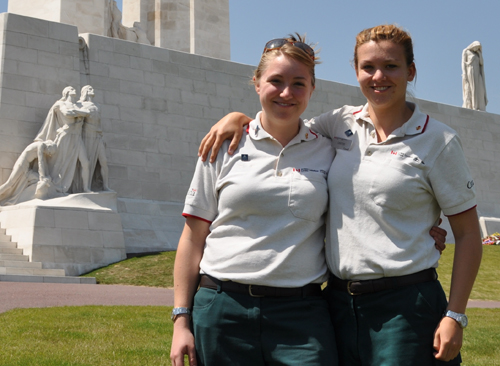
Lisette Stubbins has been able to learn more about her great-grandfather than have most of her family members, thanks to her summer job.
The U of G history student has spent three four-month terms as a tour guide at the Canadian National Vimy Memorial in the Nord-Pas-de-Calais region of France, the First World War battleground where her great-grandfather and other Canadian soldiers fought in 1917, ultimately capturing the ridge from the Germans.
“I applied to be a tour guide because I have a family connection to the site,” said Stubbins. “I think it’s important for our family to still have ties to the site and to tell the history of the Canadians, including my great-grandfather, who fought here, because they can’t tell it themselves.”
This summer, she’s working with another Guelph student, Jessica Siegel, who has also returned as a site tour guide. Siegel is studying international development and says the experience not only gives her a chance to use her French language skills, but allows her to meet people from around the globe and spend time at one of the most famous sites in Canadian military history.
“The four-kilometre stretch of ridge is where all four divisions of the Canadian Corps fought together for the first time,” said Siegel. “During this battle, the Canadians accomplished the tremendous feat of retaking the ridge. This accomplishment is known worldwide as a Canadian victory, and it was the first offensive victory. It had a role in boosting the morale of the Canadians and the British because of what was gained, and they took that momentum with them throughout the rest of the war.”
The two U of G students are among 45 Canadian students selected to participate in the Veterans Affairs Canada Student Guide Program. The students work year-round in France in four-month sessions as interpretive guides at the Canadian National Vimy Memorial and the Beaumont-Hamel Newfoundland Memorial. Their training ensures that guides know the sites and the history of the First World War, specifically Canada’s role in the conflict and events at each site.
During the past three years, Stubbins has learned what it was like for her great-grandfather at Vimy, including trench warfare and the use of tunnels for communication, shelter and surprising the enemy. Historians attribute the Canadian military success in capturing the ridge to technical and tactical innovation, meticulous planning, powerful artillery support and extensive training.
Stubbins has also learned about the harsh living conditions endured by the soldiers. “I realize now that my great-grandfather likely saw some horrific things during this battle,” she said. “It’s amazing he was able to assimilate back into his life as a bank employee when he returned from the war.”
Her training spurred her to research her great-grandfather’s experience, including his position on the battlefield and the role of his battalion. She ordered his war records and learned some facts about him that not even his closest family members knew.
“I learned from his medical records that he had a scar on his right buttock that he received during the war. Family members were surprised to hear about that one.”
Stubbins says learning these details about her great-grandfather helped her understand what shaped him into the man he was. “It’s been interesting to track his movement before and after the war,” she said. “I never met him, but all the research I have done makes me feel a lot closer to him. And even though I will never get to meet him, he has still had an effect on me.”
As experienced guides, both Stubbins and Siegel are leading tours ─ three 50-minute tours a day on average ─ and training other students this year. Siegel said one of the most important parts of their job is to teach the many student visitors about the importance of the battle.
“The high school students who visit the site are the same age as many of the soldiers who fought in the battle. We want to make sure they appreciate the sacrifice these soldiers made for future generations.”